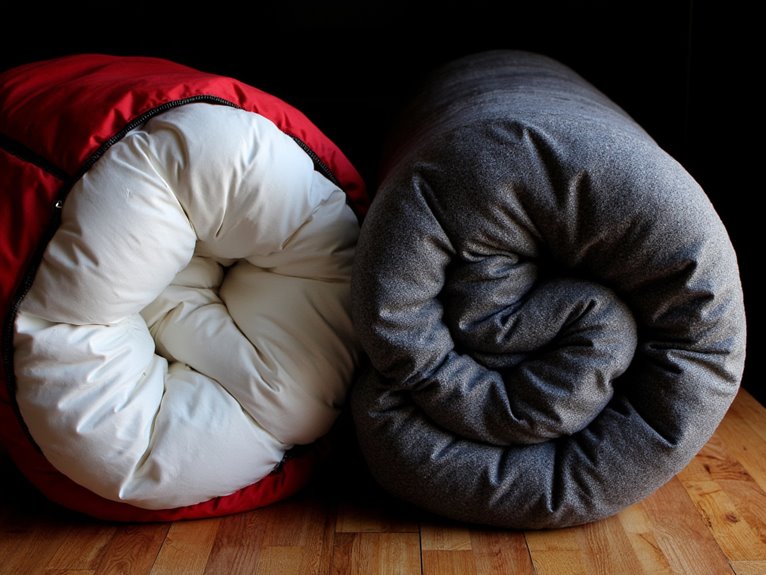What Are the Disadvantages of Dyneema?
Dyneema, a ultra-high molecular weight polyethylene (UHMWPE) fiber, has several drawbacks that can impact its performance and applicability. Its molecular structure degrades when exposed to UV light, and it absorbs moisture, causing swelling and loss of strength. High production costs, complex manufacturing processes, and material expenses contribute to its expensiveness. Additionally, Dyneema is difficult to shape and mold, exhibits creep and relaxation, and has limited chemical resistance capacity. Moreover, its production process contributes to environmental degradation, and its non-biodegradable nature raises concerns about disposal and microplastic pollution. Delve into the nuances of Dyneema's limitations to better understand its applications.
We are supported by our audience. When you purchase through links on our site, we may earn an affiliate commission, at no extra cost for you. Learn more. Last update on 1st January 2026 / Images from Amazon Product Advertising API.
Limited Resistance to UV Light
Dyneema's limited resistance to UV light is a significant drawback, as prolonged exposure can lead to degradation of its molecular structure, compromising its exceptional strength and durability.
This limitation is particularly concerning for outdoor applications, where exposure to UV light is unavoidable.
As a result, users may need to take additional measures to protect Dyneema-based products from UV radiation, such as applying UV-resistant coatings or storing them in shaded areas.
While Dyneema's high strength-to-weight ratio makes it an attractive material for various industries, its vulnerability to UV degradation cannot be overlooked.
This limitation underscores the importance of careful material selection and consideration of environmental factors in product design.
High Production and Material Costs
One of the significant drawbacks of Dyneema is the high cost associated with its production and material expenses.
The raw materials required to manufacture Dyneema are costly, contributing to the overall expense of the final product.
Additionally, the complex manufacturing process involved in creating Dyneema also drives up production costs, making it a costly material to produce.
Raw Material Expenses
Frequently, the high cost of raw materials is a significant factor contributing to the increased production expenses of Dyneema.
The cost of raw materials, such as ultra-high molecular weight polyethylene (UHMWPE), can be substantial, leading to higher production costs. This is particularly true when considering the high-quality materials required to meet Dyneema's exceptional strength and durability standards.
Some key factors influencing raw material expenses include:
- The cost of sourcing high-quality UHMWPE
- Fluctuations in global material demand and supply
- Transportation costs associated with importing raw materials
- The impact of tariffs and trade policies on material costs
Manufacturing Complexity
The production process of Dyneema is inherently complex, entailing high production and material costs due to the intricate processing requirements and specialized equipment necessary to manufacture this ultra-high-strength fiber.
The manufacturing process involves a series of elaborate steps, including gel spinning, drawing, and annealing, which demand significant investments in equipment and labor.
In addition, the high-strength properties of Dyneema require a high degree of precision and control during production, adding to the complexity and expense.
These factors contribute to the heightened production costs, making Dyneema more expensive than other high-performance fibers.
As a result, manufacturers must carefully weigh the benefits of using Dyneema against the increased costs associated with its production.
Difficulty in Melting and Forming
One of the significant drawbacks of Dyneema is its difficulty in melting and forming, which can hinder its processing and manufacturing.
This challenge arises from Dyneema's unique properties, which require specialized equipment and techniques to shape and mold the material.
As a result, manufacturers face a range of obstacles that can increase production time and costs.
High Melting Temperature
Characterized by an exceptionally high melting temperature, Dyneema poses significant challenges with regard to melting and forming, making it a material that demands specialized equipment and expertise.
This high melting temperature makes it difficult to process and shape Dyneema into desired forms, which can increase production costs and lead times.
Additionally, the high melting temperature also affects the material's weldability and moldability.
Some key implications of Dyneema's high melting temperature include:
- Restricted processing conditions to prevent degradation
- Limited material flow during forming operations
- Increased energy consumption during manufacturing
- Specialized equipment and tooling required for processing
Limited Forming Options
Dyneema's extremely high melting temperature severely limits its forming options, making it notoriously difficult to melt and shape into complex geometries.
As a result, manufacturers often struggle to produce intricate designs or complex shapes, which can be a significant limitation in various industries.
The high melting point also restricts the use of traditional forming techniques, such as injection molding or thermoforming, making it challenging to create complex parts or components.
This limitation can lead to increased production costs, reduced design flexibility, and extended lead times, ultimately affecting the overall efficiency and competitiveness of manufacturing processes.
Bonding Challenges
The bonding process of Dyneema fibers is notoriously problematic due to their extremely high melting temperature, which makes it difficult to achieve a strong bond between the fibers themselves or with other materials.
This challenge is further complicated by the fibers' low surface energy, which reduces the effectiveness of adhesives.
As a result, manufacturers often struggle to create a reliable bond, leading to reduced product performance and lifespan.
Some of the specific bonding challenges associated with Dyneema fibers include:
- Inconsistent bonding strength due to variable fiber surface properties
- Limited compatibility with common adhesives and resins
- Difficulty in achieving a uniform bond across the fiber matrix
- Increased risk of delamination or debonding under stress or environmental exposure
Prone to Creep and Relaxation
Under continuous or cyclic loading, Dyneema fibers exhibit a propensity to undergo creep and relaxation, which can lead to a loss of tensile strength and dimensional stability over time.
This phenomenon can be particularly problematic in applications where high loads are applied consistently, such as in mooring lines or heavy-lift slings.
As a result, the fibers may slowly deform, leading to a reduction in their load-bearing capacity.
This can compromise the overall performance and reliability of the material, making it essential to carefully consider the loading conditions and design parameters when working with Dyneema.
Limited Chemical Resistance Capacity
While Dyneema's exceptional mechanical properties make it an attractive choice for various applications, its limited capacity to resist degradation from chemicals can be a significant drawback.
This limitation can lead to material degradation, compromising its performance and longevity. Specifically, Dyneema exhibits poor resistance to:
- Strong acids, which can cause rapid degradation
- Alkalis, which can lead to discoloration and embrittlement
- Organic solvents, which can cause swelling and softening
- Hydrocarbons, which can lead to cracking and embrittlement
This limited chemical resistance capacity restricts Dyneema's use in certain industries, such as chemical processing, where exposure to corrosive substances is common.
As a result, users must carefully consider the environmental conditions in which Dyneema will be used to guarantee its integrity and performance.
High Moisture Absorption Rates
Frequently, Dyneema's high moisture absorption rates have significant implications for its performance, as it can lead to swelling, loss of strength, and reduced dimensional stability.
When exposed to humid or wet conditions, Dyneema fibers can absorb moisture, causing them to expand and lose their shape. This can compromise the material's structural integrity, making it more prone to damage or failure.
In addition, the absorbed moisture can also lead to a reduction in Dyneema's tensile strength, further compromising its performance.
These issues are particularly problematic in applications where dimensional stability and high strength-to-weight ratios are essential, such as in marine or outdoor gear.
As a result, users should carefully consider the environmental conditions in which Dyneema-based products will be used.
Environmental Impact Concerns
In addition to its performance limitations, Dyneema's production process and end-of-life disposal have sparked concerns about its environmental footprint, particularly in regards to microplastic pollution and resource depletion.
The production of Dyneema requires large amounts of energy and resources, contributing to greenhouse gas emissions and environmental degradation.
Additionally, the material's non-biodegradable nature raises concerns about its disposal and potential to contribute to microplastic pollution.
Some of the key environmental impact concerns surrounding Dyneema include:
- High energy consumption during production
- Contribution to microplastic pollution in waterways and soil
- Resource depletion due to raw material extraction
- Lack of biodegradability, leading to long-term environmental persistence, and in addition, its persistence in the environment has long-term consequences.




